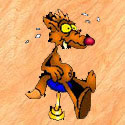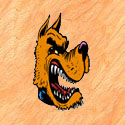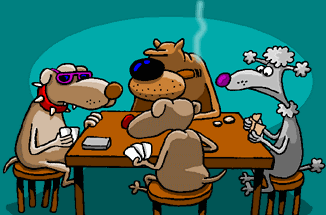
|
|
 |
Perform the temperament test to determine the personality of your puppy or dog. Use the Puppy Temperament Test for dogs under 5 months and the Adult Temperament Test for dogs over 5 months. (See the charts below!)
|
|
|
|
 |
 |
Bonds well to humans Good dogs for first time owners |
 |
 |
Unpredictable Usually not good dogs around children |
 |
 |
Unpredictable Usually not good dogs around children or other pets |
 |
 |
Good outdoor only dogs |
|
|||
|
* You will need a collar, a leash, keys, a squeaky toy, canned dog food and a |
|
|
 |
 |
 |
 |
| Pet the puppy in a stroking motion from head to toe, Lifting up feet, tail, and ears. | Is the puppy accepting and willing to be petted and examined? | Is the puppy sensitive about one particular part? | Is it sensitive about all parts? Does it try to bite your hand? | Is the puppy completely uninterested in your petting? |
| Pick the puppy up and cradle him like a baby or (for a larger dog) gently roll him over, belly up and feet in air. Place your hand gently over his throat. | Does the puppy allow you to place your hand over its throat without a struggle? | Are its eyes wide with fear and its body stiff? | Does the puppy wiggle madly to right itself? Does it growl and bite at your hand? | Does it wiggle to right itself and then hurry away to do something else? |
| Test the puppy's reaction to sound: Use your voice to
make
a) a high pitched noise b) a deep gruff noise c) a whistle. Throw a squeaky toy near the puppy. Rattle a set of keys. |
Is the puppy curious and wagging its tail? | Does the puppy look scared and run away? | Does the puppy try to bite and attack the objects? Does he bark loudly at you? | Does the puppy ignore all of the sounds and act disinterested? |
| Put a collar and leash on the puppy: Wait and observe the puppy's reaction. Then try to move a few steps with the puppy. | Does the puppy not react at all to the leash and collar or react with some curiosity? Does he walk with you? | Does it freeze in its tracks and not want to move? | Does the puppy bite at the leash and want to tug on it? | Does it completely ignore the fact that you are at the other end of the leash and show no interest in walking with you? |
| Test the puppy's reaction to the outside: Take the puppy outside. Try to find squirrels, birds, cats, and other people to expose it to. | Does it stick near to you but show a curious interest in these other things? | Does the puppy cower and run the other way? | Does it bark furiously and lunge at everything it sees? | Does it act very uninterested in the things you show it but very interested in everything else it finds on its own? |
| Test the puppy's responsiveness to food: Give the puppy food in a bowl and fill it with canned dog food. Before the puppy finishes, remove the bowl and take the food away. | Does the puppy wag its tail and look expectantly at you? | Is it too scared to eat ? | Does it bite your hands, bark, growl or jump up on you to get the food back? | Does the puppy act very uninterested? |
 * Before doing a temperament test on a grown dog, you should take some precautions. Always evaluate in the presence of another adult. If you have no background information about the dog at all, you must proceed with caution and stop if the dog shows any signs of resistance. If the dog makes no attempts to be friendly, is agitated, has a stiff stance, or is hyper-active, do not attempt to evaluate the dog. Do not evaluate an intact (un-neutered) male dog or a female dog in heat. Be sure to end the test with the dog as soon as shows signs of being aggressive in any way. * You will need a collar, a leash, a chair, a few dog toys, a 4-6' long rope, a 3' stick or a broom, a piece of paper, canned dog food and a bowl for these tests. |
|
|
 |
 |
 |
 |
| Put the dog on a leash. Test the dog's reaction to the outside: Take the dog outside. Try to find squirrels, birds, cats, and other people to expose it to. Call the dog over to look at something. | Does it walk near you but show a curious interest in these other things? | Does it cower and run the other way? | Does it bark furiously and lunge at everything it sees?
|
Does it act very uninterested in the things you show it but very interested in everything else it finds? |
| Come inside, but keep the dog on a leash. Sit in a chair and neutrally observe the dog. | Does the dog lick or nudge your hand? Does it look at you as if to ask for attention? Does it wag its tail? | Does the dog cower and avoid and interaction? | Does the dog mouth you? Does it jump up
on you roughly? |
Does the dog strain at the end of the leash toward some distant smell or noise? |
| Talk in a high-pitched, squeaky voice to the dog for 30 seconds. Stop and suddenly go neutral. | Does the dog respond to your change in behavior? | Does the dog avoid interacting with you? | Does the dog jump up, mount, or mouth you? |
Does the dog not seem affected by your change in behavior? |
| Test the dog's reaction to toys: Use toys to get the dog excited and playing for 30 seconds. Stop and suddenly drop the toy. | Does the dog play with you, but also respond to your change in behavior? | Does the dog avoid interacting with you? | Does the dog jump up, mount, or mouth you? Does
the dog take the toy and try to run off with it?
|
Is the dog unable to change in response to your change in behavior? |
| Test the dog's prey drive: With the dog on a leash, have another person run by several times, dragging a toy behind and making a "hissing noise". | Is the dog more focused on the runner than the toy? Does the dog wag its tail? | Does the dog act afraid of the runner and the noise? | Does the dog whine and strain to go after the runner? Does it
bark uncontrollably?
|
Does the dog ignore the runner and the mouse? |
| Toss a crumpled piece of paper on the ground. While the dog is sniffing it, yell "Hey! Give me that!" Use a long stick or broom handle to take the piece of paper away. | Does the dog stop immediately and come back to you as if to "apologize"? | Does the dog cower and try to run away? | Does it grab the paper and try to run off with it?
|
Does it not react at all to your yelling? |
| Pet the dog in a stroking motion from head to toe several times. Observe the dog's reaction closely. | Is it accepting and willing to be petted and examined? | Does the dog sink down under your hand? |
Does it remain very stiff? Is it sensitive about any parts?
Does it utter a growl?
|
Is it completely uninterested in your petting? |
| Test the dog's responsiveness to food: Give the dog food in a bowl and fill it with canned dog food. Before the dog finishes, use a long stick or broom handle to pull the bowl away. | Does the dog wag its tail and look expectantly at you? | Is it too scared to eat ? | Does it lift its lips, bite at the stick, bark, growl, or jump up on
you to get the food back?
|
Does it act very uninterested in food at all? |